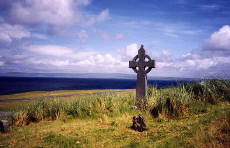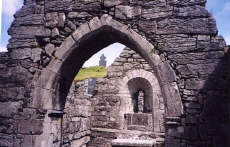Two Days on Little Inisheer:
An Aran Island Experience
County Galway, Ireland
 |
|
High cross. |
![]()
Off the coast of Galway, Ireland, some 30 miles from the mainland, three islands slumber in the Atlantic Ocean. On rainy days, they look ominous, draped in early morning mist. Dark blue water swirls around their rocky limestone landscape. White foam splashes onto the beaches of the Aran Islands that carry the Irish names Inishmore (the big island), Inishmaan (the middle island) and Inisheer (the eastern island).
DAY 1: Getting Acquainted
My boyfriend and I climb off the ferry and onto the pier, where we are greeted by the huge Irish Gaelic words “Fáilte go dtí Inis Oírr” (Welcome to Inisheer) edged in the pier wall. I hold my breath and look around. The beach is whiter than I’d expected, the sky and the water bluer, and across the green, the lush green of the Irish fields, little stone walls run criss-crossing lines.
We’ve left the bustling, friendly city of Galway and stepped into another world, another time and age. We’re on a little island, no bigger than 2½ by 1½ square miles, rich in Gaelic culture, heritage, and – forgive the use of a clichéd word – breathtaking scenery: ancient ring forts from prehistoric and early Christian times, sheep, donkeys, and ruins, ponies and thatched cottages with wild flowers growing around them – and water, everywhere I turn.
On the hill, an old ruin, O’Brien’s Castle, rises, watches gracefully over the pony traps jog-trotting along dirt roads and the few people dashing through the white sand. The mythical Irish sun, which has been our friendly companion over the past week, has followed us here. It’s picture-perfect, and I feel a rush of pride, as if I myself had lifted this little island from the depth of the sea. As if I, myself, had molded it the way it is.
And I feel relief. I had been (and had wanted to be) in charge of planning the four-week trip to Ireland. Yet I’d felt a certain trepidation as soon as I’d stepped off the plane in Dublin. It was to be our first vacation as a couple. We hadn’t seen each other in four months and it was important, oh so important to me that we’d go to beautiful places, see beautiful things. I’d searched the Internet for pictures of the island, but all I could find were a few dark, rainy, uninviting photographs. The descriptions I had read in travel books, however, made me want to go to Inisheer, see for myself. Now, as I am here, I somehow feel, I somehow know this part of our journey will be one we’ll remember fondly.
We’re staying at Sharry’s Bed & Breakfast: Good choice, close to the harbor and beach. If you ever visit this little island, you’ll find your way there. It’s easy. Everything’s easy here. Inisheer, population 300, is the smallest of the Arans.
Our tiny but lovely ensuite room is cold, clean and dark, yet the small window opens up to sunshine, the Atlantic Ocean stretching out to the horizon, white stone houses and the patchwork pattern of low drystone walls.
We’re tired, the ferry ride was choppy (and a lot of fun!), but we feel an energy that drives us out of our room as soon as we’ve dropped off our bags. Hungry and lucky to find the best establishment on the island just around the corner of our B&B, we stumble into Tigh Ned’s, a pub that bubbles with live music – Irish fiddlers and songstresses – and gallons of Guinness at night, yet it is mostly empty that early July afternoon when we first stroll through the door.
We order ham and cheese sandwiches (heated up) and Earl Grey. My boyfriend pulls out his notebook, looks around the room and starts to write. I narrow my eyes with envy. We’re both writers, both studied the craft at school. I can see his need for writing, but I can’t write – not yet. I’m taking everything in, looking at the pictures on the wall: Some of the them show the islanders in a rescue effort. In a 1960 gale a cargo vessel wrecked on the coast of Inisheer. The islanders were able to save the crew, but the Plassy sank – only to be thrown up on Carraig na Finise, a rocky Inisheer beach, a few years later – and there it still is.
The pub is so – Irish. It looks like the setting of a Nora Roberts book. I almost expect a good-looking barkeeper to turn around the corner and start singing Gaelic tunes. It is so exactly how I imagined an Irish pub that I’m worried that my perception is off. Nothing is as good as travel or fiction books say, or is it?
We’re the only guests. I see a fisherman slipping out the door after finishing a pint of Guinness. The door is the only bright spot along the gloomy pub walls and through it, I can see the sky and the sea from where I am sitting.
Strengthened, we leave Tigh Ned’s, walk along the beach, climb across rocks, venture close to the water. We take pictures that say, “Look, this is one lonely man/woman on a rock, and right behind me there’s nothing, but sea and sky, sea and sky, sea and sky.”
“We’re the only tourists here,” I say, grinning happily at my boyfriend.
“Well, not quite,” he says, carefully so as not to put a damper on my joy. He points at a few people climbing onto a pony trap.
Yes, I know, we aren’t alone here, but it feels that way. Inisheer is an island hardly visited by anyone. The most touristed of the Arans, Inishmore, bustles with visitors in the summer months and has more “attractions” to offer (“bigger better ruins” and more restaurants, pubs, and places to stay). Inishmaan is the lonely island, hillier than the other two and somewhat “godforsaken” as some guidebooks describe it. Little Inisheer, however, is bottled tranquility.
The sun paints clear, sharp, strong colors. I pull out my camera and feel slightly overwhelmed. How can I catch the green, the blue, the green, the blue? How can I catch the yellow flowers dancing in the wind? How can I catch the smell of the air brushing on my face? How can a picture say, “This is where you have to go and – just be?”
I try anyway. My camera clicks as shot by shot I feel like, at least, I’ll have something to remember this day by when I return home.
Wandering the dirt roads, we meet a raggedy, happy-looking dog. He stops in front of us, glancing at us, knowing that we need him to be the extension of our good mood. Thus, he drops down on the field, rolls around on the ground, lifting up his legs, his face almost smiling. We’re amused and light-hearted. He’s done a good deed for the content travelers.
 |
|
Church of St Kevin. |
![]()
We walk up the hill to an old graveyard on a sand dune. A soft wind swishes through the high grass as we make our way along the path, up to the stony Celtic crosses rising into the sky. Wandering through the gravestones, we read words, Gaelic words of days long gone by. A storm that rushed across the island in 1885 has cleared the sand and uncovered, sunk deep into the ground, its gables rising up to ground level, Teampall Chaomhain Caomhan, the ruins of a 10th- to 14th-century church dedicated to St. Kevin, the patron saint of Inisheer.
Walking down the hill, away from the graveyard and up again, we wander higher and higher until we reach O’Brien’s Castle. The castle, built in the 14th century, belonged to Brien Boru, the High King of Ireland. Under the rule of the O’Briens, Galway Bay was protected from pirates and, as a return favor, rich merchants paid them in gallons of wine.
As we stroll through the three ground floor rooms of the castle’s ruin (once three storeys high, now the upper two floors are gone), I wonder which room was the kitchen, which the bedroom. I wonder what people looked like, what they wore, what they were like, who they loved – and I wonder, as I step out of the shades into the bright sunlight, what Brien Boru felt, looking down the hill, seeing the water, the sky, and Galway in the distance; how he felt, protecting his little island.
We have dinner at the Fisherman’s Cottage – in a small patio in the back of the house. We’re the only guests at a little before 9:30pm, and we are glad to have dinner at all. On Inisheer, 9:30 seems to be the time when all the restaurants close – unless you want to have some pub grub. While eating quite a tasty meal (salmon salad and chicken), we are watching a lonely sheep grazing and the sun go down.
As we walk back to our B&B, “peace” is the word that comes to my mind. The city air, the city sounds, the city burdens, the daily worries fall off me. Nothing could possibly harm me here. The sea will defend my peace. The sea will lull me to sleep with strong breakers crashing against the rocks. It’ll wake me up with gentle waves lapping onto the shore.